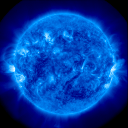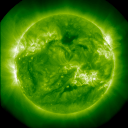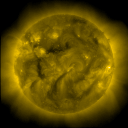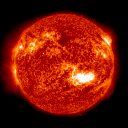| Propagation |
This page contains a dynamic collection of propagation information gathered from many different sources. This data is extremely useful for ham radio operators and shortwave listeners to help determine whether or not long distance radio communications are possible.
The current time is: 15:51 UTC on Friday, April 20, 2012
| Current Solar Indicies from WWV |
|
20-Apr-2012 at 1505
UTC SFI = 138 A = 5 K = 2 |
| Conditions during the last 24 hours |
|
No space weather storms were observed for the past 24
hours. |
| Forecast for the next 24 hours |
|
No space weather storms are predicted for the next 24
hours. |
![]()
Solar Wind Data
Provides solar wind velocity and energetic particle intensity
Updated at: 1538Z on April 20, 2012
| Velocity (km/s): | 304.0 |
| Density (protons/cm3): | 0.3 |
![]()
WWV only updates its SFI reading once a day at 2100Z
The Penticton solar observatory takes measurements at 1700Z, 2000Z, and 2300Z
(WWV uses the 2000Z Penticton measurement)
| The Penticton Observatory SFI value on 19-Apr-2012 at 2300Z was: | 139 |
![]()
(updated daily after 2200Z)
This report issued on Apr 19, 2012 at 2200Z
| Date | SFI | A-index |
| 19 Apr | 135 | 8 |
| 20 Apr | 135 | 5 |
| 21 Apr | 135 | 5 |
| Solar Activity Forecast |
| Solar activity is expected to be low during days 1 - 3 (20 - 22 April) with a chance for an isolated M-class flare. |
| Geophysical Activity Forecast |
| Geomagnetic field activity is expected to be at quiet to unsettled levels on day 1 (20 April) with a chance for brief active levels due to a recurrent solar sector boundary crossing. Quiet levels are expected during days 2- 3 (21 - 22 April). |
![]()
(usually reported within 30 minutes of event peak)
| Date | Time | Magnitude |
| 16-Apr-2012 | 1745Z | M1.7 |
![]()
This number is reported daily around 0225Z and reports
the number of sunspots observed in the previous 24 hour period
| The NOAA Sunspot number for 19-Apr-2012 was: | 122 |
| Most recent five days (oldest first): | 65 77 86 78 96 |
![]()
This value is reported daily around 0225Z and reports the
average background x-ray flux level as measured by the GOES-15 satellite
| The GOES-15 Background X-ray Flux level on 19-Apr-2012 was: | B5 |
| Most recent five days (oldest first): | B1 B2 B2 B2 B4 |
![]()
![]()
Auroral Activity
Aurora (also known as "aurora borealis" or "northern lights") is caused by interaction between the Earth's magnetic field and the solar wind (a mix of charged particles blowing away from the sun). During storms, enough of these charged particles make it through to the Earth's upper atmosphere that they interact with the earths natural magnetic field lines. When enough of these particles collide, energy is released in the form of auroral light. In addition to creating a pretty light show (mostly in upper latitudes), ham radio signals scatter off of these particles and can greatly enhance propagation on the VHF and UHF ham radio bands. High levels of aurora can also make HF ham radio propagation via polar routes difficult.
|
Real-Time
|
Real-Time
|
Click on thumbnails to view a larger image
Images courtesy of the NOAA Auroral Activity
site
Solar X-ray Flux
This chart shows X-ray flux levels as measured by the GOES-15 satellite. The measurements (shown in red) are used to issue alerts when X-ray flux levels exceed certain levels. Spikes on the chart correspond to solar flares. Flares are considered "significant" when flux levels rise above the "M" level (as shown on the right side of the chart). These large flares can often wipe out the ham radio and shortwave bands almost immediately and it can take minutes to hours for the bands to recover. If the ham radio bands seem to go dead all of a sudden, it is always a good idea to check this chart to see if a large flare has occurred recently.
Dynamically updating plots:
5-minute
X-ray 1-minute
X-ray Satellite
Environment
K-index Proton Flux Electron Flux GOES Magnetometer
Grey Line Map
The grey line is a band around the Earth that separates the daylight from darkness. Radio propagation along the grey line is very efficient. One major reason for this is that the D layer, which absorbs HF signals, disappears rapidly on the sunset side of the grey line, and it has not yet built upon the sunrise side. Ham radio operators and shortwave listeners can optimize long distance communications to various areas of the world by monitoring this area as it moves around the globe. This map shows the current position of the grey line terminator.

Click here to show a dynamically updating Grey Line map
Near-Real-Time MUF map
The following map shows Maximum Usable Frequencies (MUFs) for 3000 kilometer radio signal paths. More importantly, the current sunspot number (SSN) and Planetary A-index are updated every 30 minutes on the bottom of this image. Additionally, the grey line position, auroral ovals, and sun position are provided. Click on the map for more details on how to use it.
This image courtesy of Solar Terrestrial Dispatch
Current Sun Images
The images below are current views of the sun shown at different wavelengths of light as taken by SOHO and the Yohkoh soft-Xray telescope. Generally, more bright regions on the disk indicates more solar activity, which usually leads to higher flux levels (which also often leads to better ham radio and shortwave propagation). Click on any thumbnail to view a larger image.
|
SOHO - 17.1nm |
SOHO - 19.3nm |
|
SOHO - 21.1nm |
SOHO - 30.4nm |
Sometimes you may see the text "CCD Bakeout" instead of the images. This occurs when NASA does routine maintenance and calibration on the cameras. For a more technical explanation, read NASA CCD Bakeout explanation.
Images courtesy of the SDAC at the NASA Goddard Space Flight Center
|
|
Help support dx.qsl.net! Make your Amazon purchases by clicking on the Amazon icon. |
Layout and dynamic reports created by amateur radio N6RT
Comments or Questions? Email webmaster@dx.qsl.net


















































